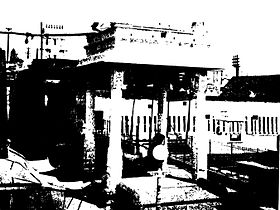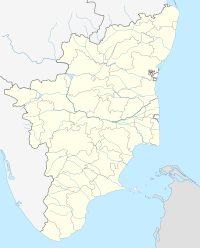- Chennakesava Perumal Temple, Chennai
-
Chennakesava Perumal Temple 
Chennakesava Perumal TempleCoordinates: 13°5′2″N 80°16′12″E / 13.08389°N 80.27°ECoordinates: 13°5′2″N 80°16′12″E / 13.08389°N 80.27°E Name Proper name: Chennakesava Perumal Temple Tamil: சென்னகேசவ பெருமாள் திருக்கோயில் Location Country: India State: Tamil Nadu District: Chennai Location: Chennai Temple Details Primary Deity: Chennakesava Perumal (Vishnu) Architecture and culture Architectural styles: Dravidian architecture Chennakesava Perumal Temple (Tamil: சென்னகேசவ பெருமாள் திருக்கோயில்) is a Hindu temple situated in the city of Chennai, India. Dedicated to Chennakesava Perumal, a manifestation of the Hindu god Vishnu and the patron deity of Chennai, the temple is the first to be built since the construction of Madras city by the British East India Company.[1]
History
The Chennakesava Perumal Temple was constructed in 1646. The temple was endowed with liberal grants by Beri Thimanna, the chief dubash and Nagabhattan, the factory's powder maker.[2] Narayanappa Aiyar was the first chief priest of the temple.[2] Built seven years after the acquisition of the site by the British East India Company, the temple is the first to be constructed in the British city of Madrasapatnam.
B. Ramaswami Nayudu in his 1820 book Memoir on the Revenue System of Madras wrote that Berry Timmappa assisted in building the town accordingly called Chennapatnam in the north side of the factory, and in inviting people from different parts of the country, by the aid of a Cowle from the Company's agents, to settle there, by allotting lands for both right and left hand castes separately. He also caused two Pagodas, one of Vistnoo and the other Sheva to be built there, calling the former Chenna Casava Perumal and the latter Chenna Malleswara, both after the same name nearly one hundred and eighty years prior, or according to the Hamilton's Gazetteer, and that of the fragments of Orme's Hindustan, in the year 1639[3]
The temple was demolished, in 1757, after the French occupation of Madras to make way for military fortifications.[2] As a compensation, the government of Madras paid more than 565 pagodas to the Hindus of Madras and provided an alternate site for a temple.[4] The shrine was eventually rebuilt in 1766 in Flower Bazaar, Peddanaickenpettah to the west of Fort St George where it now stands.[2]The Madras High Court stands on the site of the original temple.[4]
Notes
- ^ Srinivasachari, Introduction, p xxix
- ^ a b c d Srinivasachari, Development of the Settlement, pp 24-25
- ^ Vestiges of Old Madras 1640-1800. pp. 92-96.
- ^ a b Tourist Guide to Tamil Nadu. Sura Books. p. 19. ISBN 81-7478-177-3, ISBN 978-81-7478-177-2.
References
- Srinivasachari, C. S. (1939). History of the city of Madras written for the Tercentenary Celebration Committee. Madras: P. Varadachary & Co..
Categories:- Hindu temples in Chennai
Wikimedia Foundation. 2010.

